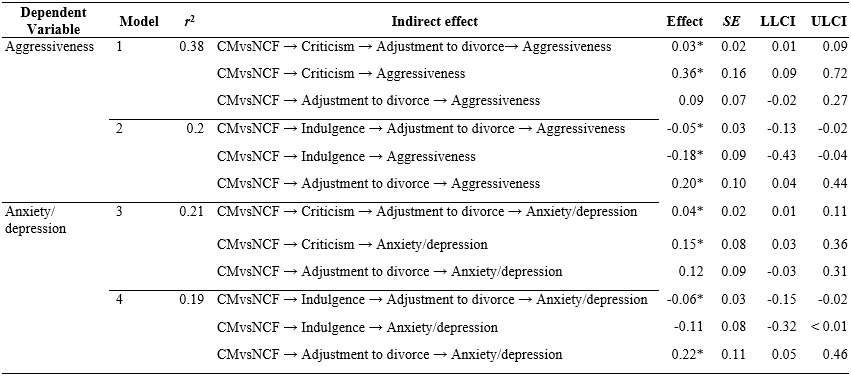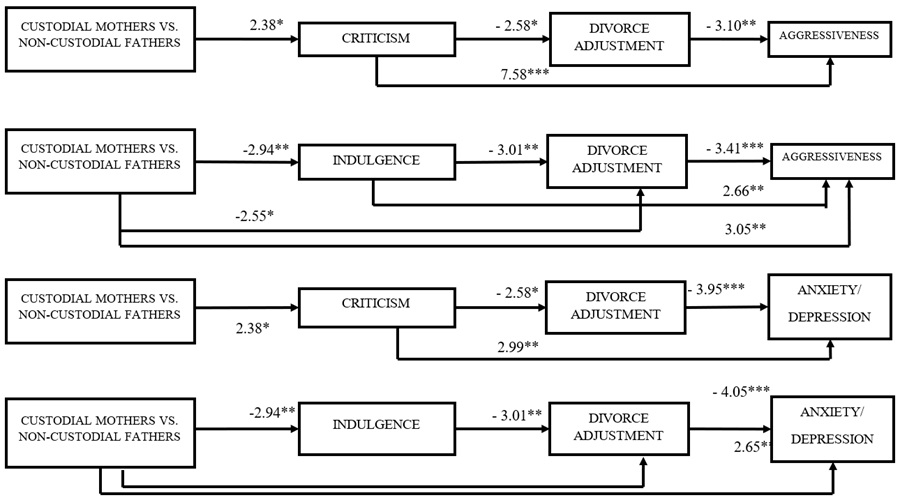Achenbach, T. M. (1991). Manual for the Child Behavior Checklist and Profile. Burlington, VT: University of Vermont, Department of Psychiatry.
Adamsons, K. (2018). Quantity versus quality of nonresident father involvement: Deconstructing the argument that quantity doesn’t matter. Journal of Child Custody, 1–9. doi: 10.1080/15379418.2018.1437002
Amato, P. (2000). The consequences of divorce for adults and children. Journal of Marriage and the Family, 62, 1269–1287. doi:10.1111/j.1741-3737.2000.01269.x
Amato, P., & Cheadle, J. (2008). Parental divorce, marital conflict and children's behavior problems: A comparison of adopted and biological children. Social Forces, 86(3), 1139-1161.
Bastaits, K., & Mortelmans, D. (2014). Does the parenting of divorced mothers and fathers affect children’s well-being in the same way? Child Indicators Research, 7, 351–367.
Bastaits, K., & Mortelmans, D. (2016). Parenting as mediator between post-divorce family structure and children's well-being. Journal of Child and Family Studies, 25(7), 2178-2188. doi:10.1007/s10826-016-0395-8
Bastaits, K., & Mortelmans, D. (2017). Parenting and family structure after divorce: Are they related? Journal of Divorce & Remarriage, 58(7), 542-558. doi:10.1080/10502556.2017.1345200
Bastaits, K., Ponnet, K., & Mortelmans, D. (2012). Parenting of divorced fathers and the association with children’s self-esteem. Journal of Youth and Adolescence, 41(12), 1643-1656. doi: 10.1007/s10964-012-9783-6
Bastaits, K., Ponnet, K., & Mortelmans, D. (2014). Do divorced fathers matter? The impact of parenting styles of divorced fathers on the well-being of the child. Journal of Divorce & Remarriage, 55(5), 363-390. doi:10.1080/10502556.2014.920682
Bersabé, R., Fuentes, M. J., & Motrico, E. (2001). Análisis psicométrico de dos escalas para evaluar estilos educativos parentales [Psychometric analysis of two scales to assess parental educational styles]. Psicothema, 13(4), 678-684.
Bögels, S., & Perotti, M. (2011). Does father know best? A formal model of the paternal influence on childhood social anxiety. Journal of Child and Family Studies, 20(2), 171-181.
Bögels, S., & Phares, V. (2008). Fathers' role in the etiology, prevention and treatment of child anxiety: A review and new model. Clinical Psychology Review, 28(4), 539-558.
Campana, K. L., Henderson, S., Stolberg, A. L., & Schum, L. (2008). Paired maternal and paternal parenting styles, child custody and children’s emotional adjustment to divorce. Journal of Divorce & Remarriage, 48, 1–20.
Capano, A., González, M. L., & Massonnier, N. (2016). Estilos relacionales parentales: Estudio con adolescentes y sus padres. Revista de Psicología, 34(2), 413-444.
Chang, H., Olson, S., Sameroff, L., & Sexton, A. (2011). Child effortful control as a mediator of parenting practices on externalizing behavior: Evidence for a sex-differentiated pathway across the transition from preschool to school. Journal of Abnormal Child Psychology, 39(1), 71-81.
Chen, W., Wu, C., & Yeh, K. (2016). How parenting and filial piety influence happiness, parent-child relationships and quality of family life in Taiwanese adult children. Journal of Family Studies, 22(1), 80-96. doi:10.1080/13229400.2015.1027154
Cohen, N. J., Costello, E. I. & McConsughy, S. H. (1982). The relationship between children’s internalizing and externalizing symptom patterns and measures of competence: A study of the concurrent validity of the Achenbach. Child Behavior Profile. Dallas, TX: American Academy of Child Psychiatry.
Cohen, O., Finzi‐Dottan, R., & Tangir‐Dotan, G. (2014). The fatherhood experience of divorced custodial fathers in Israel. Family Relations, 63(5), 639-653. doi:10.1111/fare.12092
Cooper, C. E., McLanahan, S. S., Meadows, S. O., & Brooks-Gunn, J. (2009). Family structure transitions and maternal parenting stress. Journal of Marriage and Family, 71(3), 558-574. doi:10.1111/j.1741-3737.2009.00619.x
Elam, K., Sandler, I., Wolchik, S., & Tein, J. (2016). Non-residential father-child involvement, interparental conflict and mental health of children following divorce: A person-focused approach. Journal of Youth and Adolescence, 45(3), 581-593. doi:10.1007/s10964-015-0399-5
Elam, K. K., Sandler, I., Wolchik, S. A., Tein, J.-Y., & Rogers, A. (2019). Latent profiles of postdivorce parenting time, conflict, and quality: Children’s adjustment associations. Journal of Family Psychology, 33(5), 499–510. doi:10.1037/fam0000484
Fabricius, W. V., & Luecken, L. J. (2007). Postdivorce living arrangements, parent conflict, and long-term physical health correlates for children of divorce. Journal of Family Psychology, 21(2), 195–205. doi:10.1037/0893-3200.21.2.195
Fabricius, W., Suh, G., & Lamb, M. E. (2017). Should infants and toddlers have frequent overnight parenting time with fathers? The policy debate and new data. Psychology, Public Policy, and Law, 23(1), 68-84. doi:10.1037/law0000108
Falconier, M. (2013). Traditional gender role orientation and dyadic coping in immigrant Latino couples: Effects on couple functioning. Family Relations, 62(2), 269-283. doi: 10.1111/fare.12002
Fehlberg, B., Smyth, B., Maclean, M., & Roberts, C. (2011). Legislating for shared time parenting after separation: A research review. International Journal of Law, Policy and the Family, 25(3), 318-337. doi:10.1093/lawfam/ebr015
Feldman, R. (2003). Infant–mother and infant–father synchrony: The co-regulation of positive arousal. Infant Mental Health Journal, 24(1), 1-23.
Flouri, E., Buchanan, A., & Bream, V. (2002). Adolescents’ perceptions of their fathers’ involvement: Significance to school attitudes. Psychology in the Schools, 39, 575-582.
Fuentes, M. J., Motrico, E., & Bersabé, R. M. (1999). Escala de Afecto (EA) y Escala de Normas y Exigencias (ENE): Versión hijos y versión padres [Scale of Affection (EA) and Scale of Rules and Demands (ENE): Parent version and children versión]. Universidad de Málaga.
García, F., & Gracia, E. (2009). Is always authoritative the optimum parenting style? Evidence from Spanish families. Adolescence, 44(173), 101-31.
Guajardo, N.R., Snyder, G., & Petersen, R. (2009). Relationships among parenting practices, parental stress, child behaviour, and children's social-cognitive development. Infant and Child Development. 18, 37–60. doi:10.1002/icd.578
Hayes, A. F. (2013). An introduction to mediation, moderation, and conditional process analysis: A regression-based approach. New York, NY: The Guildford Press.
Instituto Nacional de estadística [INE]. (2017). Estadística de nulidades, separaciones y divorcios. Año 2017 [Statistics of annulments, separations and divorces. Year 2017]. Retrieved from https://www.ine.es/prensa/ensd_2017.pdf
Jurma, A. (2015). Impact of divorce and mother's psychological well-being on children's emotional, behavioral, and social competences. Revista de Cercetare Si Interventie Sociala, 48, 69-82.
Keating, A., Sharry, J., Murphy, M., Rooney, B., & Carr, A. (2016). An evaluation of the Parents Plus–Parenting when Separated Programme. Clinical Child Psychology and Psychiatry, 21(2), 240-254. doi:10.1177/1359104515581717
King, V. (2006). The antecedents and consequences of adolescents’ relationships with step-fathers and nonresident fathers. Journal of Marriage and Family, 68, 910 – 928. doi:10.1111/ jomf.2006.68.issue-4
King, V., & Sobolewski, J. M. (2006). Nonresident fathers’ contributions to adolescent well- being. Journal of Marriage and Family, 68, 537–557. doi:10.1111/jomf.2006.68.issue-3
Lamb, M. (1981). The role of the father in child development (2nd ed. comp. rev. and updated. ed., Wiley Series on Personality Processes). New York: John Wiley & Sons.
Lamela, D., Figueiredo, B., Bastos, A., & Feinberg, M. (2016). Typologies of post-divorce coparenting and parental well-being, parenting quality and children’s psychological adjustment. Child Psychiatry & Human Development, 47(5), 716-728.
Lengua, L. J., Wolchik, S. A., Sandler, I. N., & West, S. G. (2000). The additive and interactive effects of parenting and temperament in predicting adjustment problems of children of divorce. Journal of Clinical Child Psychology, 29, 232 – 244. doi:10.1207/ S15374424jccp2902_9
Li, L., Bai, L., Zhang, X., & Chen, Y. (2018). Family functioning during adolescence: The roles of paternal and maternal emotion dysregulation and parent–adolescent relationships. Journal of Child and Family Studies, 27(4), 1311-1323. doi:10.1007/s10826-017-0968-1
Liem, J. H., Cavell, E. C., & Lustig, K. (2010). The influence of authoritative parenting during adolescence on depressive symptoms in young adulthood: Examining the mediating roles of self-development and peer support. Journal of Genetic Psychology, 171(1), 73-92.
Lundahl, B. W., Tollefson, D., Risser, H., & Lovejoy, M. C. (2008). A meta-analysis of father involvement in parent training. Research on Social Work Practice, 18(2), 97-106.
Majdandzic, M., Möller, E., De Vente, W., Bögels, S., & Van den Boom, D. (2014). Fathers' challenging parenting behavior prevents social anxiety development in their 4-year-old children: A longitudinal observational study. Journal of Abnormal Child Psychology, 42(2), 301-10.
Marsiglio, W., Amato, P., Day, R., & Lamb, M. (2000). Scholarship on fatherhood in the 1990s and beyond. Journal of Marriage and Family, 62(4), 1173-1191.
Martin, A., Ryan, R., & Brooks-Gunn, J. (2010). When fathers' supportiveness matters most: Maternal and paternal parenting and children's school readiness. Journal of Family Psychology, 24(2), 145-155. doi:10.1037/a0018073
Mason, H., Barnett, D., Lee, S., Partridge, R., & Stacks, A. (2011). Nonresident fathers parenting and child and adolescent development, ProQuest Dissertations and Theses.
McKinney, C., Milone, M. C., & Renk, K. (2011). Parenting and late adolescent emotional adjustment: Mediating effects of discipline and gender. Child Psychiatry and Human Development, 42(4), 463-481.
National Institute of Child Health and Human Development, Early Child Care Research Network (2009). Family-peer linkages: The mediational role of attentional processes. Social Development, 18(4), 875-895.
Paquette, D. (2004). Theorizing the father‐child relationship: Mechanisms and developmental outcomes. Human Development, 47(4), 193-219.
Park, H., & Bauer, S. (2002). Parenting practices, ethnicity, socioeconomic status and academic achievement in adolescents. School Psychology International, 23(4), 386-395.
Pasley, K., & Braver, S. L. (2004). Measuring father involvement in divorced, non-resident fathers. In R. D. Day & M. E. Lamb (Eds.), Conceptualizing and measuring father involvement (pp. 217 – 240). Mahwah, NJ: Erlbaum.
Peters, B., & Ehrenberg, M. F. (2008). The influence of parental separation and divorce on father-child relationships. Journal of Divorce & Remarriage, 49, 78–109. doi:10.1080/10502550801973005
Querido, J., Warner, T., & Eyberg, S. (2002). Parenting styles and child behavior in African American families of preschool children. Journal of Clinical Child & Adolescent Psychology, 31(2), 272-277. doi:10.1207/S15374424JCCP3102_12
Rhoades, K. A., Leve, L. D., Harold, G. T., Neiderhiser, J. M., Shaw, D. S., & Reiss, D. (2011). Longitudinal pathways from marital hostility to child anger during toddlerhood: Genetic susceptibility and indirect effects via harsh parenting. Journal of Family Psychology, 25(2), 282–291. doi:10.1037/a0022886
Sandler, I., Miles, J., Cookston, J., & Braver, S. (2008). Effects of father and mother parenting on children’s mental health in high and low conflict divorces. Family Court Review, 46(2), 282-296.
Sandler, I., Wheeler, L., Braver, S., & Kaslow, N. (2013). Relations of parenting quality, interparental conflict, and overnights with mental health problems of children in divorcing families with high legal conflict. Journal of Family Psychology, 27(6), 915-924. doi:10.1037/a0034449
Sardinero, E., Pedreira Massa, J.L., & Muñiz, J. (1997). El cuestionario CBCL de Achenbach: adaptación española y aplicaciones clínico-epidemiológicas [Achenbach’s CBCL questionnaire: Spanish adaptation and clinical -epidemiological applications]. Clínica y Salud, 8(3), 447-480.
Scanlon, N., & Epkins, M. (2015). Aspects of mothers’ parenting: Independent and specific relations to children’s depression, anxiety, and social anxiety symptoms. Journal of Child and Family Studies, 24(2), 249-263.
Schudlich, T. D., & Cummings, E. M. (2007). Parental dysphoria and children's adjustment: Marital conflict styles, children's emotional security, and parenting as mediators of risk. Journal of Abnormal Child Psychology, 35(4), 627-639. doi:10.1007/s10802-007-9118-3
Schwartz, S. J., & Finley, G. E. (2005). Fathering in intact and divorced families: Ethnic differences in retrospective reports. Journal of Marriage and Family, 67(1), 207-215. doi:10.1111/j.0022-2445.2005.00015.x
Shek, D. (2001). Paternal and maternal influences on family functioning among Hong Kong Chinese families. The Journal of Genetic Psychology, 162(1), 56-74./doi.org/10.1080/00221320109597881
Stallman, H., & Ohan, J. (2016). Parenting style, parental adjustment, and co-parental conflict: Differential predictors of child psychosocial adjustment following divorce. Behaviour Change, 33(02), 112-126
Stright, A. D., & Yeo, K. L. (2014). Maternal parenting styles, school involvement, and children's school achievement and conduct in Singapore. Journal of Educational Psychology, 106(1), 301-314.
Sutherland, K. E., Altenhofen, S., & Biringen, Z. (2012). Emotional availability during mother-child interactions in divorcing and intact married families. Journal of Divorce & Remarriage, 53, 126–141. doi:10.1080/10502556.2011.651974
Tancred, E., & Greeff, A. (2015). Mothers’ parenting styles and the association with family coping strategies and family adaptation in families of children with ADHD. Clinical Social Work Journal, 43(4), 442-451. doi:10.1007/s10615-015-0524-7
Taylor, D., Purswell, K., Lindo, N., Jayne, K., & Fernando, D. (2011). The impact of child parent relationship therapy on child behavior and parent-child relationships: An examination of parental divorce. International Journal of Play Therapy, 20(3), 124-137. doi:10.1037/a0024469
Trautmann-Villalba, P., Gschwendt, M., Schmidt, M., & Laucht, H. (2006). Father-infant interaction patterns as precursors of children’s later externalizing behavior problems. European Archives of Psychiatry and Clinical Neuroscience, 256(6), 344-349.
Trinder, L., Kellet, J., & Swift, L. (2008). The relationship between contact and child adjustment in high conflict cases after divorce or separation. Child and Adolescent Mental Health, 13(4), 181-187. doi:10.1111/j.1475-3588.2008.00484.x
Vandervalk, I., Spruijt, E., De Goede, M., Meeus, W., & Maas, C. (2004). Marital status, marital process, and parental resources in predicting adolescents’ emotional adjustment: A multilevel analysis. Journal of Family Issues, 25(3), 291-317. doi:10.1177/0192513X03257429
Vazsonyi, A. T. (2003). Parent-adolescent relations and problem behaviors: Hungary, the Netherlands, Switzerland, and the United States. Marriage and Family Review, 32, 161-187.
Wallerstein, J. S., & Lewis, J. M. (2004). The unexpected legacy of divorce: Report of a 25- year study. Psychoanalytic Psychology, 21(3), 353-370. doi:10.1037/0736-9735.21.3.353
Wallerstein, J., Lewis, J., & Rosenthal, S. P. (2013). Mothers and their children after divorce: Report from a 25-year longitudinal study. Psychoanalytic Psychology, 30(2), 167-187. doi:10.1037/a0032511
Wang, H., & Amato, P. (2000). Predictors of divorce adjustment: Stressors, resources, and definitions. Journal of Marriage and Family, 62(3), 655-668. doi:10.1111/j.1741-3737.2000.00655.x
Wood, J., Repetti, J., & Roesch, R. (2004). Divorce and children’s adjustment problems at home and school: The role of depressive/withdrawn parenting. Child Psychiatry and Human Development, 35(2), 121-142. doi:10.1007/s10578-004-1881-6
Yarnoz-Yaben, S., & Comino, P. (2010). El CAD-S, un instrumento para la evaluación de la adaptación al divorcio-separación [The CAD-S, an instrument for the evaluation of adjustment to divorce-separation]. Psicothema, 22(1), 157-162.
Yárnoz-Yaben, S., Comino, P., & Garmendia, A. (2012). Parental adjustment to divorce and behaviour problems in children from divorced families, Infancia y Aprendizaje, 35(1), 37-47. doi:10.1174/021037012798977485
Yárnoz-Yaben, S., & Comino, P. (2012). Un instrumento para la evaluación del perdón en el ámbito del divorcio y la separación [An instrument to assess forgiveness in the area of divorce and separation]. International Journal of Psychology and Psychological Therapy, 12(1), 49–58.
Yilmaz, A., & Fişiloglu, H. (2005). Turkish parents' post-divorce adjustment. Journal of Divorce & Remarriage, 42(3-4), 83-107. doi:10.1300/J087v42n03_06
Yin, X., Li, Z., & Su, L. (2012). Fathers' parenting and children's adjustment: The mediating role of father-child conflict. Social Behavior and Personality, 40(8), 1401-1408.
Zimmerman, D. K., Brown, J. H., & Portes, P. R. (2004). Assessing custodial mother adjustment to divorce: The role of divorce education and family functioning. Journal of Divorce & Remarriage, 41(1-2), 1-24.














